Towards the end of the 1960’s both the USA and Soviet Union had their eyes firmly on the Moon, but away from the lunar race plans were beginning to take shape for longer duration flights within Low Earth Orbit (LEO). Designs for Space Stations came into focus both for civilian and military purposes and these studies led to a need for a new generation of ships that could perform the logistical roles that would be generated by these orbital outposts.
Here we’ll take a look at two contemporary concepts from that era. They were designed to carry out broadly similar roles, yet one had its feet firmly in the earlier days of the space race, while the other created an enduring legacy that lasts to this day in the biggest space construction of them all, the International Space Station (ISS).
By 1968 both of the key players in the space race were beginning to flight test their latest generation of crewed ships, but both programmes had also been beset by early tragedies. In the United States, the crew of Apollo 1 had been lost in January 1967 as a flash fire engulfed the Command Module during a countdown test killing Astronauts Grissom, Chaffee and White. In April 1967, Cosmonaut Vladimir Komarov had perished after the troubled flight of Soyuz 1 had ended in a parachute malfunction.
Apollo would make its first crewed flight on October 11th 1968 with the Apollo 7 mission. Soyuz followed close on it’s heels with the flight of Soyuz 3 on October 26th. All seemed set for a final showdown in the trip to the Moon as it was announced Apollo 8 would go into lunar orbit and the Soviet Soyuz derived Zond missions made uncrewed flights around the Moon in preparation for a manned attempt. (For more on the race to fly around the Moon CLICK HERE)
Whilst this race held public attention, designers on both sides were looking at what would happen next. For the United States there was the prospect of their first space station, an orbital workshop created from converted Apollo hardware a survivor of the ambitious Apollo Application Program (AAP) which had been significantly curtailed in the aftermath of the Apollo 1 hearings. This NASA project – eventually christened Skylab – would be the public face of long duration orbital spaceflight, but running in parallel was a shadowy Department of Defence (DoD) project known as the Manned Orbiting Laboratory (MOL).
MOL and Almaz
Announced in August 1965, MOL was to be a crewed military station equipped with advanced optical and electronic instruments to allow for intelligence gathering. The 2 person crew would launch with the station in an adapted version of NASA’s versatile Gemini capsule known as Gemini B. Upon reaching orbit, they would transfer through a hatch cut in the heat shield, through a pressurised tunnel into the station. Once their mission was complete they would transfer back into the Gemini B with any materials that needed to return and detach from the station returning to Earth.
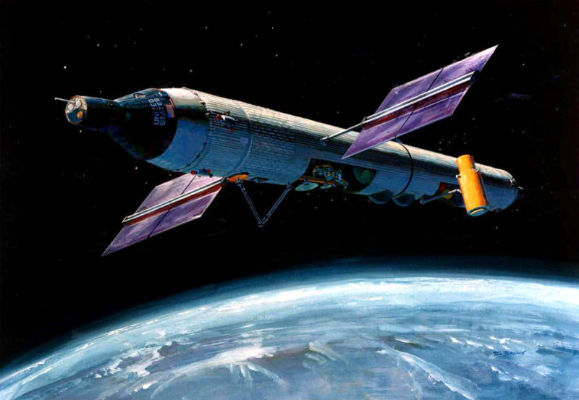
[IMG: via National Reconnaissance Office]
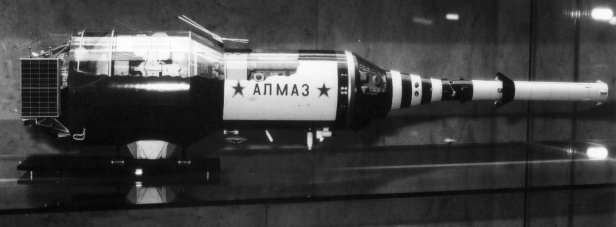
Plans for Big G
While the DoD continued to develop their plans for MOL, McDonnell Douglas (formerly McDonnell) who had manufactured NASA’s Mercury and Gemini ships and were designing the Gemini B for MOL were quick to look for other potential uses for their vehicle. NASA were examining plans for an ambitious follow-on programme to Apollo. this plan would include the construction of several large space stations, nuclear ferry craft and an eventual trip to Mars in the 1980s. Recognising that this plan would require a logistics ferry for moving crew and supplies to these stations, McDonnell Douglas approached NASA in late 1967 with a concept of a greatly enlarged Gemini B, known as Big Gemini or more commonly Big G.
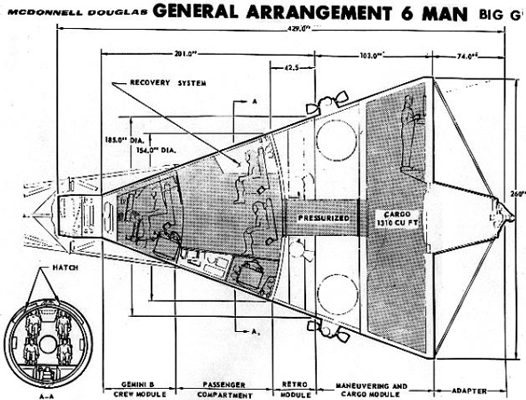
Following re-entry the crew capsule would return under either a Rogallo wing or a controllable ‘cloverleaf’ canopy to make a horizontal landing on skids at an assigned landing base echoing the original plans for NASA’s Gemini. Hedging their bets somewhat, McDonnell Douglas presented a variety of potential configurations and launch vehicles for Big G. Proposed launchers initially included the Titan III (also proposed for MOL), the Saturn 1B or a new Saturn V derived heavy launcher, the Saturn INT-20.
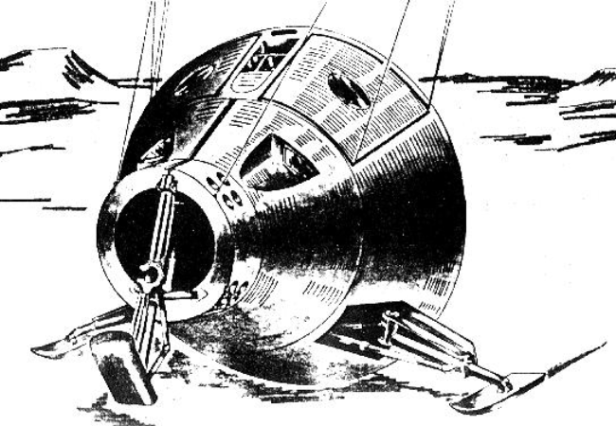
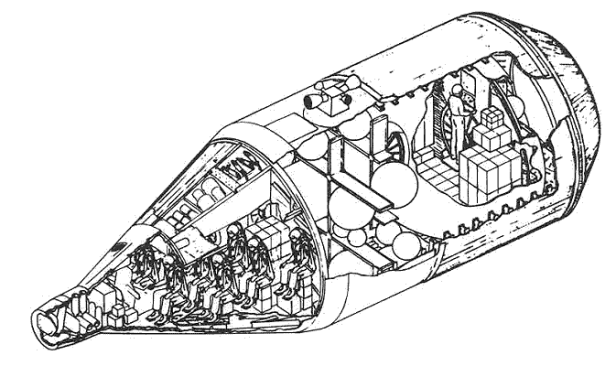
More problematic though was the decision from NASA to move towards a re-usable winged Shuttle to allow routine and economical access to LEO. While Acting Administrator Thomas O. Paine fought a long battle with the Nixon Administration regarding NASA’s ambitions post-Apollo, it quickly became clear there would be no large 12 person space station in the foreseeable future, never mind trips to Mars.
While the early years of Shuttle development were themselves mired in politics, it was clear that this provided a more pragmatic route forward given NASA’s new more constrained budgetary realities. In 1971, the Big G concept was finally eliminated from NASA’s future plans marking the end of the Gemini story. (For more on the early development stages of the Shuttle CLICK HERE)
The TKS takes shape
Following the October 1965 decree, work on Chelomei’s Almaz station continued. Recognising that it would take time to develop the TKS ship, Chelomei decided to push forward with Almaz using an adapted version of the Soyuz, the 7K-TK, as the crew ferry. This had been develop by a branch of Korolev’s OKB-1 to support an earlier military project, Soyuz-R, which had been cancelled in favour of Almaz. By 1967 though, Chelomei decided to drop this element in favour of a crewed ship of his own design known as the Vozvraschaemyi Apparat (VA). This conical capsule was a more advanced version of the LK-1 vehicle he had proposed for the circumlunar mission and would allow up to 3 cosmonauts to launch with the Almaz on his UR-500K Proton booster. As with the Gemini B capsule, a hatch in the heat shield would allow the crew access to the station via a pressurised tunnel. Interestingly, the VA was also designed to be re-usable with a projected life of up to 6 flights for each capsule.
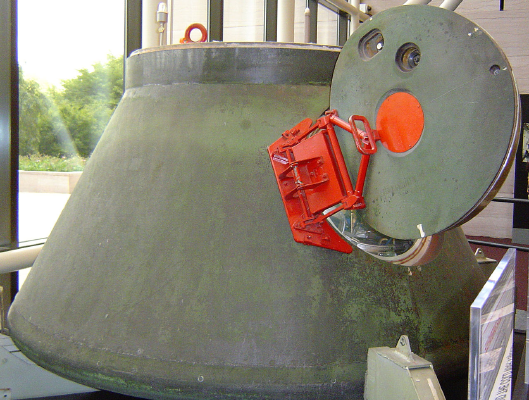
While Chelomei concentrated on the Almaz station and the VA re-entry apparatus, he passed work on the TKS supply ship over to his Fili branch, under the direction of Viktor Bugayskiy. Initial planning for the TKS was completed during 1969 and development of the vehicle was officially approved during June 1970. The TKS would consist of 2 major elements, the VA re-entry apparatus similar to the one designed for Almaz and the Funktsionalno-gruzovoy blok or Functional Cargo Block (FGB) which would be a large cylindrical area behind the VA where cargo and supplies could be carried. As with the Big G the docking port would be at the rear of the craft and a station would be included here to allow a cosmonaut to monitor the final stages of the docking process. The TKS’s role would go far beyond that of a simple ferry though. It would be equipped with 2 large solar arrays and powerful manoeuvring thrusters meaning that once attached to Almaz, it could provide additional electrical power and carry out any orbital correction burns required. Once the cargo had been unpacked from the FGB, this also served as a large additional working space for the station’s crew.
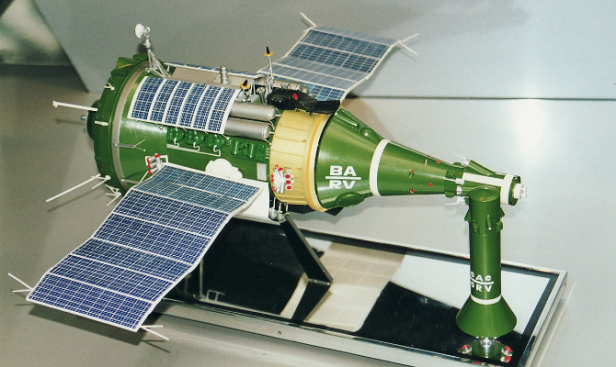
Almaz under pressure
As with most programmes originating from TsKBM (formerly OKB-52), the development of Almaz was slow and subject to external events. Following his enthusiastic patron Khrushchev’s removal from power in late 1964, Chelomei’s star was burning considerably less brightly and he had some powerful opponents within both government ministries and other design bureaus. As the Soviets faced embarrassment in the wake of the success of the Apollo moon landings in 1969, a plan was hatched to place a space station into orbit as soon as possible to support the official assertion that they had never intended to go to the Moon.
While it might have seemed sensible to bring Almaz out of the black, key personalities including the powerful Secretary for the Central Committee for Defence & Space, Dmitriy Ustinov and the head of TsKBEM (formerly Korolev’s OKB-1) Vasiliy Mishin, had other ideas. In early 1970 it was decided that Chelomei should hand over 4 of the completed Almaz hulls to Mishin. TsKBEM would then fit these hulls out with simpler non-military systems and they would become the DOS stations, better known as Salyut, to be served by the Soyuz 7K-T ferry craft.
Chelomei had little option but to capitulate to these demands and hope that he could continue to develop Almaz for his military clients without further interference. By this time he had abandoned his earlier plans to use the VA descent apparatus to launch crews with Almaz, instead opting to send crews aloft in the Soyuz 7K-T once the station was established in orbit. Further discussions with Mishin led to an agreement that only 4 of the DOS stations would be developed and after this Almaz would take over while TsKBEM looked to future heavier stations.
TKS/VA testing begins
As both the Military Almaz and the civilian DOS programmes progressed through the early-mid 1970’s, work had been slow on the TKS transport ship, but by Chelomei was able to re-focus and aimed to begin unmanned flights of the craft by 1976 with crewed flight following by 1978. As work on the FKB continued at the Fili branch, Chelomei concentrated on the VA return apparatus and getting this through the various tests required to flight rate it.
From 1974, a series of tests of the emergency rescue system (analogous to the launch escape systems of Mercury and Apollo) were carried out, proving its efficacy. Next came orbital tests of the capsules and for this Chelomei came up with the ingenious idea of launching two capsules at a time on a single UR-500K allowing him to accelerate the programme. On December 15th 1976, the first of these test was carried out with both VA capsules performing as expected and being recovered safely. A second test in mid 1977 was less successful with a booster malfunction meaning one of the VA capsules was lost. A third test was carried out in early 1978 with both capsules being successfully recovered. A forth test, also successful followed in May 1979. Interestingly, during these tests many of the capsules were flown multiple times, proving Chelomei’s original design goal of re-usability for the VA.
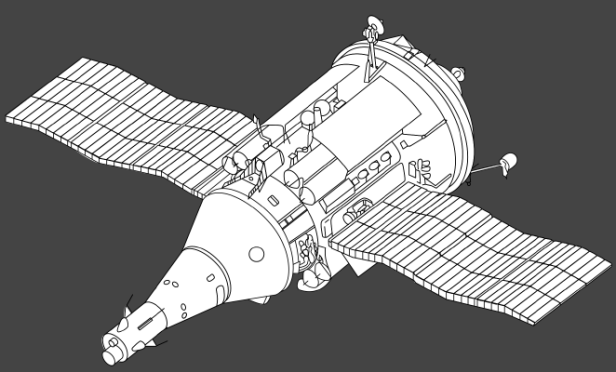
Almaz and Chelomei reach the end of the road…
Even as Chelomei was finally proving his that his TKS would be a capable vehicle, the Almaz OPS programme it had been built to support was reaching the end of it’s journey. Having flown 3 times as Salyut 2, 3 and 5 with varying success (Salyut 2 suffered depressurisation before a crew could be sent to join it) in June 1978 a decree was issued to discontinue any further piloted flights of Almaz.
However, this decree did not spell the end for the TKS as a role still existed supporting the civilian DOS Salyut programme. In April 1981 an uncrewed TKS was launched on a mission to rendezvous with Salyut 6. Known as Kosmos-1267, the vehicle again carried out a range of orbital manoeuvres which were followed by the separation and return of the VA capsule at the end of May. Meanwhile the occupants of Salyut 6 installed an adaptor to the forward end of the station to allow the remaining FGB to dock. Prior to the docking attempt, the crew returned to Earth, but on June 19th 1981 Kosmos-1267 finally docked to create the largest Soviet space complex yet. Various experiments and test took place including using the FGB’s thrusters to carry manoeuvre the complex.
This successful test marked Chelomei’s final achievement in the Soviet space programme. During June 1981 he was informed that control of his Fili branch would now be assumed by NPO Energiya, the design bureau that had succeeded TsKBEM following Mishin’s removal and Valentin Glushko’s subsequent appointment as Chief Designer. Chelomei hoped he could still launch one of the completed OPS Almaz craft on an unmanned mission, but these hopes were also dashed as Ustinov stepped in to prohibit any such mission. The final blow came in December 1981 as a decree was issued to officially terminate any further work on Almaz and prevent TsKBM from any further work on space related projects. Chelomei found himself officially out of the space business without ever seeing a crew fly in one of his craft.
…but the TKS survives
With Chelomei gone and his former Fili branch now under Glushko’s control and renamed KB Salyut, work on the TKS continued. A third vehicle was prepared for flight, this time to rendezvous and dock with Salyut-7. The launch took place on March 2nd 1983 with the vehicle named Kosmos-1443 once reaching orbit. Docking with Salyut-7 took place a week later. The new Salyut station required no special adapter as it had been manufactured to accommodate the TKS on one of its docking ports. This meant that, once docked, the crew could enter the TKS and access the supplies it had carried into orbit. Now firmly docked, the TKS took over the responsibility for manoeuvring the station. The craft remained docked to Salyut-7 until August 14th when it detached with the VA apparatus returning it’s cargo safely to Soviet soil on August 23rd. The FGB section remained in orbit for a further month before burning up during re-entry.
As the TKS continued to prove itself, western intelligence agencies were curious as to it’s true purpose. In an Air Force Foreign Technology bulletin dated January 1984, analysts speculate about the TKS – referred to as Cosmos-929 – and it’s possible role in weapons tests. Indeed, given the size and ability to launch with a crew they conclude the vehicle is “…expected to perform military operations such as reconnaissance, surveillance and military Research and Development.” Responding to Soviet reassurances that the craft represented a station re-supply ferry and ‘space-tug’ the bulletin concludes “…the openness by the Soviets concerning this spacecraft may be designed as a smoke screen to conceal an additional military function of the vehicle.” Clearly, for US analysts the large re-supply vehicle was being viewed as an independent station on a par to MOL, but a year prior to this assessment the Cosmonaut group that had been training to fly the TKS had been disbanded.
The TKS Legacy
Having proved itself a capable design, the TKS now began to evolve to support the next generation of Soviet stations. Without the need for a dedicated return apparatus, the VA was now discarded and attention turned to the potential offered by the FGB. In 1984, with plans being finalised for expansion modules for the new Mir station the FGB formed the basis for the new 77K module design. This basic design was used extensively as the Kvant-2, Kristall, Spektr and Priorida sections of the station.
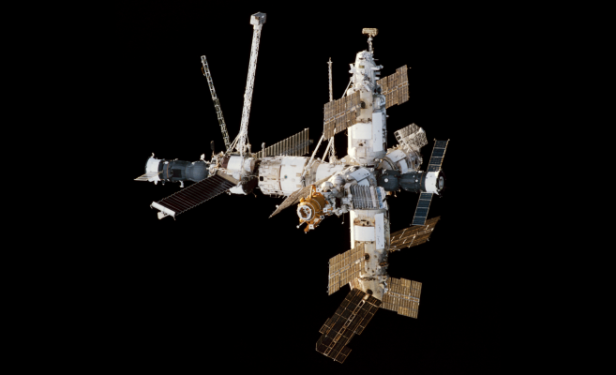
As both the American Space Station Freedom and the Russian Mir-2 had been cancelled due to budgetary constraints, it appeared that international co-operation provided the most practical means by which to create a new space station. Other international partners such as Japan, Canada and the European Space Agency (ESA) were brought in and on November 20th 1998 the first module of the International Space Station was launched from Baikonur on a Proton K. Known as Zarya (meaning Dawn in Russian) it was fitting that the module should fly into orbit atop Chelomei’s UR-500 as it’s design is based directly on the FGB Functional Cargo Block of his TKS.
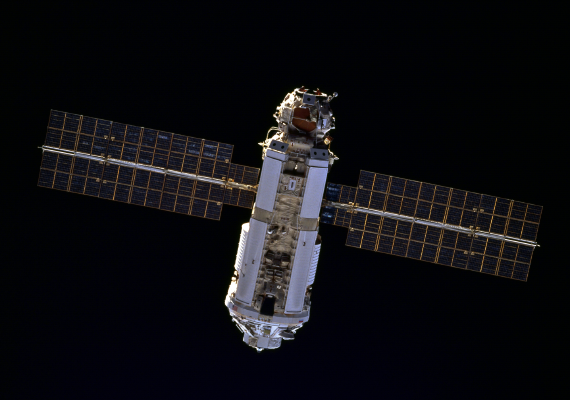
With regards to the role of Space Station supply ferry, both Big G and the TKS could probably have proved successful. They show many similarities in their basic configurations they seem a case study in parallel evolution, from their roots supporting Military stations down to details like the heat shield hatches. Undoubtedly Chelomei would have benefitted from greater access to American plans, but characteristically for an OKB-52 concept, the design of the TKS shows many original ideas.
The Big G was essentially killed off as it was trying to provide a solution to a problem that never really existed – moving crews of 9-12 people to and from large orbital stations. As hard as McDonnell Douglas tried to push the concept, NASA never really needed it. The Shuttle on the other hand provided them with one huge advantage; even if all other crewed space projects were cancelled the Shuttle alone could perform a huge variety of missions far beyond those of a logistics ferry. Ironically, in a post-Shuttle world, we find ourselves in a position where vehicles broadly similar to Big G will provide the logistical support to the ISS.
The TKS on the other hand offered a huge amount of flexibility beyond the ferry role, proving itself a capable addition to the Salyut stations and surviving long after the cancellation of Almaz. The fact the craft was retained following Ustinov’s removal of Chelomei speaks to its clear utility as does the fact it eventually left behind its original purpose entirely to become part of the permanent infrastructure of both Mir and the ISS. The VA capsule never flew with Cosmonauts despite seeming to offer advantages over Soyuz in many respects, notably its proven re-usability. It has now been consigned to museums as something of a curiosity – a little known footnote in the Soviet space story.
Author’s Note
While this article has touched upon the histories of both the MOL and Almaz stations, I have done so only in the detail required to provide supporting background detail to Big G’s Gemini B heritage and the TKS’s original design role. Both Military stations are fascinating stories in their own right and well worth the reader researching further.
Sources
Big G proposal document (20 December 1967) – McDonnell Douglas
Big G Final Report: Logistic Spacecraft System Evolving From Gemini (21 August 1969) – McDonnell Douglas
The Big G (Spaceflight Vol 57 November 2015) – Dwayne A. Day
The Space Shuttle Decision: NASA’a search for a reusable space vehicle – T. A. Heppenheimer
Gemini: Steps To The Moon – David J. Shayler
The Almaz Space Station Complex: A history 1964-1992 Part 1 (Journal of the British Interplanetary Society Vol 54 Nov/Dec 2001) – Asif A. Siddiqi
The Almaz Space Station Complex: A history 1964-1992 Part 2 (Journal of the British Interplanetary Society Vol 55 Jan/Feb 2002) – Asif A. Siddiqi
The Soviet Space Race with Apollo – Asif A. Siddiqi
Air Force Foreign Technology Bulletin: FTD-2660P-127/01-84 (12 January 1984) – USAF Foreign Technology Division
Secret Projects: Military Space Technology – Bill Rose
The Origins and Evolution of Mir and its modules (Journal of the British Interplanetary Society Vol 51 1998) – Bart Hendrickx

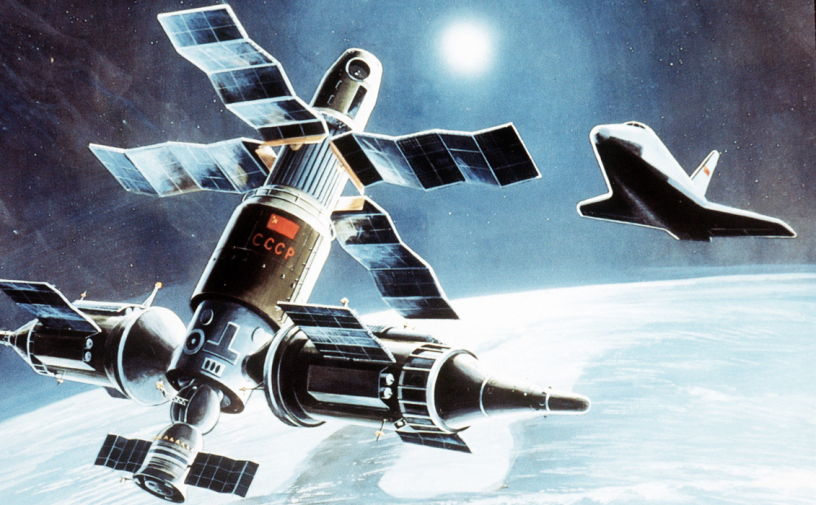
Chris, this is a great article–thanks for posting it!
I am interested in the evolution of Gemini-B into Big G, which you have described nicely. Soon, I hope to publish an article related peripherally to that linkage.
In the mean time, I hope you will look at my blog, http://www.AstroCryptoTriviology.com, especially my MOL posts. Any feedback is welcome.
John Charles
LikeLike
John,
Thanks for your kind comments. I took a quick look at your blog, but plan to read through the MOL stuff in greater detail.
For Big G I really recommend getting hold of Dwayne Day’s article in Spaceflight, it’s as good an account as I’ve read. There is also a Big G thread that he contributed to on the nasaspaceflight.com forum
Regards
Chris
LikeLike